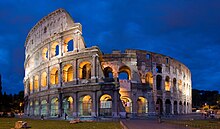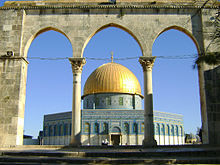Monument






A monument is a type of structure that was explicitly created to commemorate a person or event, or which has become important to a social group as a part of their remembrance of historic times or cultural heritage, or as an example of historic architecture. The term 'monument' is often applied to buildings or structures that are considered examples of important architectural and/or cultural heritage.[1]
Etymology
The origin of the word "monument" comes from the Latin moneo, monere, which means 'to remind', 'to advise' or 'to warn',[2] suggesting a monument allows us to see the past thus helping us visualize what is to come in the future.[3] In English the word "monumental" is often used in reference to something of extraordinary size and power, as in monumental sculpture, but also to mean simply anything made to commemorate the dead, as a funerary monument or other example of funerary art.
Creation and functions
Monuments have been created for thousands of years, and they are often the most durable and famous symbols of ancient civilizations. Prehistoric tumuli, dolmens, and similar structures have been created in a large number of prehistoric cultures across the world, and the many forms of monumental tombs of the more wealthy and powerful members of a society are often the source of much of our information and art from those cultures.[4] As societies became organized on a larger scale, so monuments so large as to be difficult to destroy like the Egyptian Pyramids, the Greek Parthenon, the Great Wall of China, Indian Taj Mahal or the Moai of Easter Island have become symbols of their civilizations. In more recent times, monumental structures such as the Statue of Liberty and Eiffel Tower have become iconic emblems of modern nation-states. The term monumentality relates to the symbolic status and physical presence of a monument.
Monuments are frequently used to improve the appearance of a city or location. Planned cities such as Washington D.C., New Delhi and Brasília are often built around monuments. For example, the Washington Monument's location was conceived by L'Enfant to help organize public space in the city, before it was designed or constructed. Older cities have monuments placed at locations that are already important or are sometimes redesigned to focus on one. As Shelley suggested in his famous poem "Ozymandias" ("Look on my works, ye Mighty, and despair!"), the purpose of monuments is very often to impress or awe.
Structures created for others purposes that have been made notable by their age, size or historic significance may also be regarded as monuments. This can happen because of great age and size, as in the case of the Great Wall of China, or because an event of great importance occurred there such as the village of Oradour-sur-Glane in France. Many countries use Ancient monument or similar terms for the official designation of protected structures or archeological sites which may originally have been ordinary domestic houses or other buildings.
Monuments are also often designed to convey historical or political information. They can be used to reinforce the primacy of contemporary political power, such as the column of Trajan or the numerous statues of Lenin in the Soviet Union. They can be used to educate the populace about important events or figures from the past, such as in the renaming of the old General Post Office Building in New York City to the James A. Farley Building (James Farley Post Office), after former Postmaster General James Farley.[5]
The social meanings of monuments are rarely fixed and certain and are frequently 'contested' by different social groups. As an example: whilst the former East German socialist state may have seen the Berlin Wall as a means of 'protection' from the ideological impurity of the west, dissidents and others would often argue that it was symbolic of the inherent repression and paranoia of that state. This contention of meaning is a central theme of modern 'post processual' archaeological discourse.
Protection and preservation
The term is often used to describe any structure that is a significant and legally protected historic work, and many countries have equivalents of what is called in United Kingdom legislation a Scheduled Monument, which often include relatively recent buildings constructed for residential or industrial purposes, with no thought at the time that they would come to be regarded as "monuments".
Until recently, it was customary for archaeologists to study large monuments and pay less attention to the everyday lives of the societies that created them. New ideas about what constitutes the archaeological record have revealed that certain legislative and theoretical approaches to the subject are too focused on earlier definitions of monuments. An example has been the United Kingdom's Scheduled Ancient Monument laws.
Other than municipal or national government that protecting the monuments in their jurisdiction, there are institutions dedicated on the efforts to protect and preserve monuments that considered to possess special natural or cultural significance for the world, such as and UNESCO's World Heritage Site programme[6] and World Monuments Fund.[1]
Recently, more and more monuments are being preserved digitally (in 3D models) through organisations as CyArk.[7]
Types
- Buildings designed as landmarks, usually built with an extraordinary feature, such being designed as the tallest, largest, or most distinctive design, e.g., the Burj Khalifa in Dubai, the world's tallest structure.
- Cenotaphs (intended to honor the dead who are buried elsewhere) and other memorials to commemorate the dead, usually war casualties, e.g., India Gate and Vimy Ridge Memorial, or disaster casualties, such as the Titanic Memorial, Belfast.
- Church monuments to commemorate the dead, located above or near their grave, often featuring an effigy, e.g., St. Peter's Basilica or the medieval church Sta Maria di Collemaggio in L'Aquila.
- Columns, often topped with a statue, e.g., Berlin Victory Column, Nelson's Column in London, and Trajan's Column in Rome.
- Eternal flames that are kept burning continuously, usually lit to honor unknown soldiers, e.g., at the Tomb of Unknown Soldier in Moscow
- Fountains, water-pouring structures usually placed in formal gardens or town squares, e.g., Fontaines de la Concorde and Gardens of Versailles.
- Gravestones, small monuments to the deceased, placed at their gravesites, e.g., the tombs and vaults of veterans in Les Invalides and Srebrenica Genocide Memorial.
- Mausoleums and tombs to honor the dead, e.g., the Great Pyramid of Giza and Taj Mahal.
- Monoliths erected for religious or commemorative purposes, e.g., Stonehenge.
- Mosque monuments, places of worship that usually feature highly skilled calligraphy and geometric artwork, e.g., the Mosque of the Prophet.
- Mounds erected to commemorate great leaders or events, e.g., Kościuszko Mound.
- Obelisks, usually erected to commemorate great leaders, e.g., Cleopatra's Needle in London, the National Monument ("Monas") in Central Jakarta, and the Washington Monument in Washington, D.C.
- Palaces, imposing royal residences designed to impress people with their grandeur and greatness, e.g., Forbidden City in Beijing, Palace of Versailles, and Schwerin Palace in Schwerin. and Palace of Versailles.
- Searchlights to project a powerful beam of light, e.g., Tribute in Light in the National September 11 Memorial & Museum in New York City, commemorating the September 11 attacks of 2001.
- Statues of famous individuals or symbols, e.g., the Niederwalddenkmal (Germania) in Hesse, the Statue of Liberty in New York City, and The Motherland Calls in Volgograd.
- Temples or religious structures built for pilgrimage, ritual or commemorative purposes, e.g., Borobudur in Magelang and Kaaba in Mecca.
- Terminating vistas, layout design for urban monuments on the end of an avenue, e.g., Opera Garnier in Paris.
- Triumphal arches, almost always to commemorate military successes, e.g., the Arch of Constantine in Rome and Arc de Triomphe de l'Étoile in Paris.
- War memorials, e.g., the Iwo Jima Memorial in Arlington, VA, the Laboe Naval Memorial, the Lorraine American Cemetery and Memorial in St Avold,[8] and the Soviet War Memorial in Berlin.
Examples of notable monuments
-
Independence Monument in Kyiv commemorate the Independence of Ukraine
-
The Statue of Liberty, the symbol of the United States' freedom
-
The Cristo Redentor, a modern religious monument in Brazil
-
The Cathedral of Santiago de Compostela where Saint James is buried
-
The Bell Telephone Memorial, commemorates the invention of the telephone, Brantford, Ontario
-
The Hiroshima Cenotaph and Atomic Bomb Dome to remember the victims of August 6, 1945 atomic bombing
See also
- Antiquities Act
- English Heritage Archive, holds data on England's monuments
- Memorial
- Monumental sculpture
- National memorial
- National monument
References
- ^ a b "Preserving Cultural Heritages". wmf.org. World Monument Fund. Retrieved 2013-10-23.
- ^ "Monument - definition of". thefreedictionary.com. The Free Dictionary by Farlex. Retrieved 2013-10-23.
- ^ John Young Cole; Henry Hope Reed (1997). The Library of Congress: The Art and Architecture of the Thomas Jefferson Building. Norton. p. 16. ISBN 978-0-393-04563-5.
- ^ Patton, Mark (1993) Statements in Stone: Monuments and Society in Neolithic Brittany. Routledge, London, ISBN 0415067294, pp. 1–7
- ^ David Gardner Chardavoyne (2012), United States District Court for the Eastern District of Michigan: People, Law, and Politics, Wayne State University Press, p. 194
- ^ "World Heritage". unesco.org.
- ^ CyArk preserving monuments digitally. slashgear.com. October 22, 2013
- ^ "Lorraine American Cemetery and Memorial". abmc.gov.
Further reading
- Choay, Françoise (2001). The invention of the historic monument. Cambridge University Press.
- Gangopadhyay, Subinoy (2002). Testimony of Stone : Monuments of India. Dasgupta & Co.
- Phillips, Cynthia & Priwer, Shana (2008). Ancient Monuments. M E Sharpe Reference.
{{cite book}}: CS1 maint: multiple names: authors list (link) - Stierlin, Henri (2005). Great monuments of the ancient world. Thames & Hudson.














